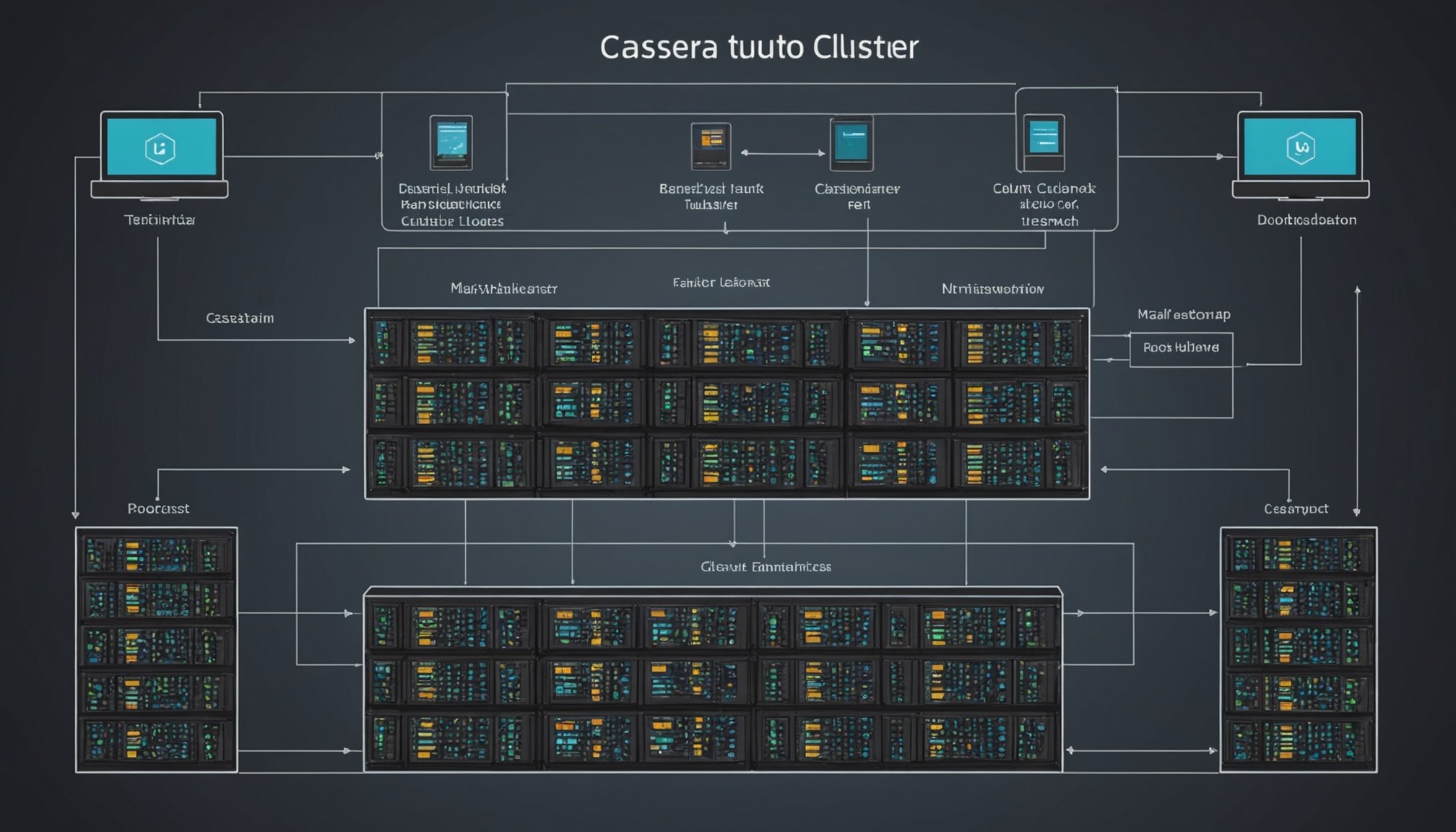Prerequisites for Establishing a Cassandra Cluster
Before diving into building a Cassandra Cluster, it’s essential to consider specific prerequisites that ensure efficient operation and scalability.
System Requirements
When planning a multi-node Cassandra setup, the first step involves understanding the system requirements. Each node should run on a dedicated server with a minimum of 8 GB RAM and multi-core CPU to handle the demanding workload. Since Cassandra is I/O intensive, SSDs are recommended for optimal performance.
Also to discover : Mastering High Availability: Step-by-Step Guide to Setting Up PostgreSQL with Read Replicas
Software Installations and Dependencies
Ensure that Java is installed, as Cassandra is a Java-based application. It’s recommended to use the latest stable version. Apache Cassandra itself should be installed using its appropriate binary packages. Don’t forget Python, which is often a prerequisite for running certain Cassandra tools or scripts.
Network Configurations and Hardware
Network configuration plays a crucial role in a Cassandra Cluster. Nodes should be on the same data center and have a low-latency network connection. It’s important to configure IP addresses and listening ports properly. Hardware considerations include choosing servers with balanced CPU, RAM, and storage based on your workload requirements.
In the same genre : Mastering CI/CD: A Step-by-Step Guide to Setting Up Bitbucket Pipelines for Your Java Spring Boot App
By meeting these Cassandra Cluster Prerequisites and properly configuring your hardware, software, and network, you lay a solid foundation for a robust, scalable cluster that can efficiently manage data across nodes.
Understanding Cassandra Architecture
Apache Cassandra is a renowned NoSQL database, celebrated for its scalable and fault-tolerant architecture.
Node Composition
In Cassandra, a node represents a fundamental building block within the cluster. Essential roles and responsibilities are distributed among these nodes. Each node is independently capable of handling data read and write requests. Their composition ensures that the database remains highly available even in case of node failures. Such a decentralized approach naturally facilitates linear scalability and fault tolerance.
Data Distribution Mechanism
Cassandra’s data distribution mechanism pivots around a robust partitioning strategy. Data is evenly distributed across nodes, courtesy of consistent hashing. This technique ensures balanced data loads, enhancing performance and reliability. By breaking data into smaller chunks across the cluster, Cassandra efficiently manages large datasets while avoiding bottlenecks.
Replication Strategies
Replication is pivotal for Cassandra’s fault tolerance. Data gets replicated across multiple nodes, offering strong data availability guarantees. Depending on the tailored requirements, Cassandra offers flexible strategies like SimpleStrategy for single data centers and NetworkTopologyStrategy for multi-datacenter deployments. These strategies ensure data redundancy, providing needed safety against hardware failures.
Cassandra’s architecture is emblematic of innovation in database design, turning conventional constraints into a modern, scalable system, ready for varied data loads.
Step-by-Step Installation Process
Setting up Apache Cassandra on multiple nodes can initially appear daunting, but by following these Cassandra Installation Steps, you can ensure a smooth and efficient process. This section provides a detailed walkthrough of installing Cassandra, highlighting essential configurations and verifications.
First, ensure you have Java installed on all machines, as Cassandra requires the Java Runtime Environment (JRE). Check the installed Java version by running the command java -version. Once confirmed, download the latest stable version of Cassandra from the official site.
After downloading, extract the contents on each machine. Navigate to the Cassandra directory and edit the cassandra.yaml file. Within this file, configuration of necessary environment variables is essential. Set the cluster_name uniformly across all nodes and modify the listen_address to the IP address of each machine.
Further, add each node’s address to the seeds property. This establishes critical connections between nodes.
With configurations finalized, proceed to install Cassandra by running the command sudo bin/cassandra -f. Following this, verification is crucial. Use nodetool status to check successful installations across nodes, ensuring each is listed as “UN” (Up and Normal). Consistently verify through this tool to maintain the stability of the installation.
Configuration Best Practices
When configuring Cassandra, the cassandra.yaml file serves as the primary tool for customization. This configuration file is essential for adjusting various settings that directly impact the system’s performance and stability.
YAML Configuration Overview
The cassandra.yaml file contains a range of parameters that dictate how Cassandra operates. It includes settings for nodes, storage options, and replication strategies, among others. Properly configuring this file is crucial for efficient data handling and resource management.
Key Configuration Parameters
Several critical parameters within the cassandra configuration should be prioritized. For instance, the cluster_name must be correctly set to ensure proper node identification. The num_tokens parameter helps in distributing data evenly, enhancing load balancing. Another important parameter is memtable_cleanup_threshold, which aids in managing memory effectively.
Performance Optimization
Optimizing Cassandra’s performance involves fine-tuning its configuration. Prioritize performance optimization by adjusting garbage collection settings and configuring disk I/O throughput. Monitoring tools and performance metrics play a pivotal role in these efforts. Utilize solutions like Prometheus or Grafana to ensure that your system remains efficient and reliable. Additionally, regular checks on read and write latency help in identifying bottlenecks, guiding targeted tuning efforts.
Testing the Fault-Tolerance Mechanism
In today’s digital landscape, ensuring fault-tolerance is critical for maintaining seamless operations. Let’s delve into some essential strategies for fault-tolerance testing.
Firstly, to evaluate a cluster’s response to failures, it’s crucial to simulate node failure scenarios. This can involve deliberately shutting down nodes to observe how the system manages the loss of resources. Such simulations help verify that data recovery processes efficiently restore information from backups, ensuring no data is permanently lost.
Moreover, testing data replication strategies is vital. By checking how swiftly and accurately data reproduces across nodes, one can ascertain the system’s ability to maintain data integrity. Ensuring timely replication prevents data loss during potential outages and maintains service continuity.
Additionally, examining the cluster’s behavior during outages can reveal critical insights. Observing how the system redirects tasks and maintains performance under duress is crucial. A robust fault-tolerance mechanism will enable smooth rerouting and resource reallocation, minimizing downtime and disruption.
In conclusion, employing these testing methods not only helps in maintaining high performance but also builds trust in a system’s resilience against possible faults. Testing ensures that even when individual components fail, the system as a whole remains reliable and effective.
Troubleshooting Common Issues
Understanding Cassandra Troubleshooting is vital to maintaining your database’s efficiency. Below, we explore monitoring cluster health, addressing common errors, and tapping into community resources.
Cluster Health Monitoring
Effective monitoring begins with comprehending cluster metrics, such as read/write latency and disk usage. Utilising tools like nodetool and JMX monitoring can offer insights into these parameters. A well-monitored cluster operates smoothly, helping you avert potential issues before they escalate.
Common Errors and Fixes
One prominent issue in Cassandra is the Out of Memory (OOM) error, often caused by improper heap space allocation. Resolve this by adjusting the JVM heap size appropriately. Another frequent concern is read/write timeouts, usually addressed by fine-tuning timeout settings in the cassandra.yml configuration file. Regularly checking system logs helps identify these problems early.
Community Resources for Support
The Cassandra community offers a wealth of resources, making problem-solving more accessible. Engage with forums such as the Cassandra mailing list and communities like Stack Overflow for user insights. Additionally, the Apache Cassandra documentation is a reliable reference, providing in-depth explanations and best practices to sustain your system.
These strategies and resources will help maintain stable and reliable Cassandra operation, ensuring minimal disruptions to your work.











